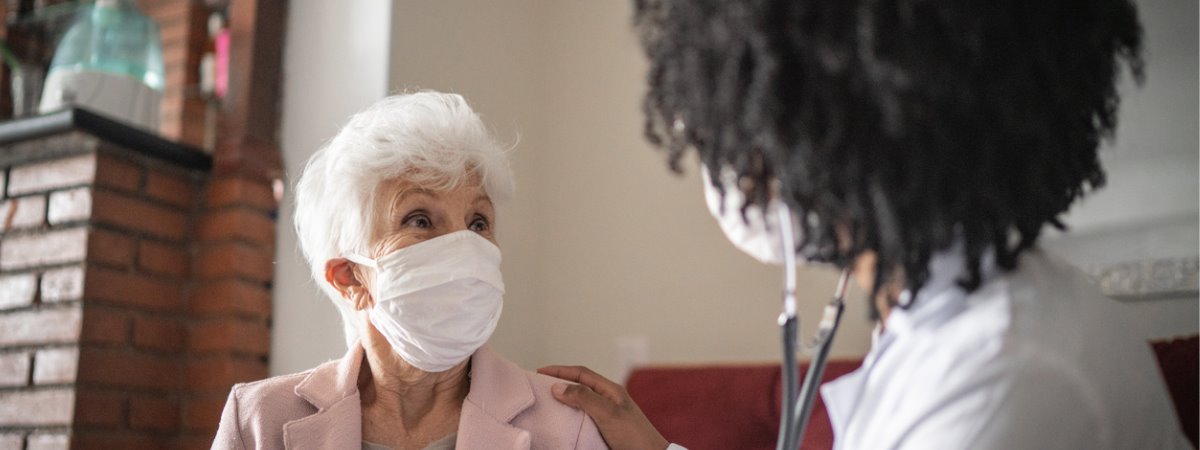To say we’re living in uncertain times is an understatement. We’re scared and confused and unsure of what could hurt us first – an unknown virus, a deepening economic downturn, or growing political tensions. Uncertainty about our future physical and financial health, combined with the pressures of required social distancing have increased our worry and stress. And the number of people in the US experiencing high levels of psychological distress has noticeably increased from the pre-COVID-19 era.
More patients are missing critical in-person screenings or are coming to the hospital too late for potentially life-saving treatment. For people living with serious chronic conditions, these feelings of fear, anxiety, and worry can be amplified, manifesting into various degrees of harm. Those with serious, acute conditions are often avoiding the hospital due to a fear of catching COVID-19 and are consequently ending up sicker, or are dying.
Alarmingly, from March to May, visits to hospital emergency departments decreased by nearly 40 percent. This is despite measures of how sick emergency department patients rose 20 percent between March and May. Last Spring, non-COVID-19 out-of-hospital deaths increased, while in-hospital mortality has declined. Almost half of these decreases (45 percent) are being seen in patients with cancer diagnoses, heart attacks (40 percent), and strokes (30 percent). Some leading health systems believe the death toll for these individuals may reach levels comparable to COVID-attributed deaths if patients continue delaying their care.
The widespread messaging around social distancing, the rapidly changing information about the virus, portrayal of the virus’ danger on media, together with changes in our external surroundings all play into individual cognitive biases influencing how to perceive the threat of COVID-19 and guide decisions. To further complicate matters, rising unemployment has also led to real tradeoffs around care and affordability. Nearly half of Americans say they or someone they live with has delayed care since COVID-19 began, which may be exacerbated as re-openings are paused and relief funding is set to expire.
Nearly half of Americans say they or someone they live with has delayed care since COVID-19 began.
Addressing Patients’ Fears of Critical Inpatient Procedures
Ensuring physical safety for patients through operational procedures and processes is absolutely essential. However, addressing patients’ fears will require something more – it will take developing deeper, more meaningful human connections. For years in healthcare, we’ve talked about the need for greater patient engagement. It's more relevant than ever today during a time of crisis, and in a world where everyone craves understanding and connection. It’s not enough to just talk about it; it needs to be practiced so patients feel it.
To form these deeper relationships, we need increased empathy, or “the process of recognizing what someone else is feeling, then experiencing that same feeling, and producing the appropriate response.”
For a patient, this can be as simple as receiving a personal phone call – one where staff asks more questions, interrupts less, remains curious, and takes the time to simplify and clarify details around patient and caregiver concerns regarding returning for care. And, by continually asking “why” to get past symptoms of a problem and get to deeper levels of understanding on the roots of their fear. A call where the staff pays attention to a patient’s tone of voice, which can be more revealing than what is actually being said. And through such a conversation, exploring the patient’s deepest concerns and uncovering how to best address these. Engaging in a feedback and affirmation loop – “This is what I’m hearing you say, and I took this action.” – to help a patient feel heard by acknowledging and responding to their emotions.
It’s How to Show Up, Not Just What to Say
This ingrained habit of continuously listening and responding uncovers the sliding door moments – a term coined by John Gottman and the researchers behind the Love Lab to describe the seemingly inconsequential everyday moments that make or break relationships. These little things don’t have immediate returns or cost very much. Yet, their effects build up over time.
Empathy in medicine has long been associated with surprising results: increased patient satisfaction, better patient outcomes (such as improved adherence to therapy, fewer medical errors, and malpractice claims), and decreased physician/nurse burnout. Patients treated with empathy are more likely to disclose all relevant information related to their conditions and return for follow up appointments. Recent surveys note that patients most valued a call from their primary care doctor telling them it was safe to come in for care.
COVID-19 has been a catalyst for many industries to take empathy a step further and seek ways to evolve their relationships with consumers.
Other companies outside of healthcare have found ways to create that deep connection for large volumes of people. They’ve been able to do so through a multi-pronged approach and addressing at different levels:
- Ecosystem: Leveraging partnerships with other players who complement and address existing gaps in capabilities
- Programmatic: Understanding their customers, systematically collecting feedback through individual connections, and designing large programs that address specific concerns
- Individual: Ingraining a mindset and culture of empathy by training, practicing, cascading, and reinforced through leadership, management, and operational structures
COVID-19 has been a catalyst for many industries to take empathy a step further and seek ways to evolve their relationships with consumers. For example, it’s precipitated the importance of forging deeper personal connection while enabling progress to solve real needs, whether that’s a larger societal problem or making a small request in a consumer’s daily life easier.
The pandemic has catalyzed the need for healthcare organizations to connect differently with patients to enhance their care. The act of meaningfully connecting can play an outsized role to help reassure high-risk patients about the safety of getting the critical care they need in person. This will become more important than ever, as healthcare organizations, patients, the US, and the world, navigate the long road of uncertainty ahead.


